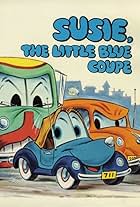Hoping for a son to redeem his name, Casey has several daughters instead who happen to be all dynamite baseball players themselves.Hoping for a son to redeem his name, Casey has several daughters instead who happen to be all dynamite baseball players themselves.Hoping for a son to redeem his name, Casey has several daughters instead who happen to be all dynamite baseball players themselves.
June Foray
- The Caseyettes
- (uncredited)
William Woodson
- Narrator
- (uncredited)
- Directors
- Writers
- All cast & crew
- Production, box office & more at IMDbPro
Storyline
Did you know
- TriviaIncluded on the 2000 Disney DVD of Melody Time (1948)
- ConnectionsFeatured in The Magical World of Disney: Three Tall Tales (1963)
Featured review
A Walt Disney Cartoon.
CASEY BATS AGAIN when it looks as though the Casyettes, his all-daughter team, may lose the big game.
This lively & colorful little film was a sequel to CASEY AT THE BAT, one of the sequences in MAKE MINE MUSIC (1946), which itself was a spoof of the famous poem by Ernest Lawrence Thayer. What it's missing is the tremendous contribution the musical recitation by Jerry Colonna made to its predecessor. However, the good humor, fine animation and gentle nudge for women's rights more than compensate for any lack in presentation.
Walt Disney (1901-1966) was always intrigued by pictures & drawings. As a lad in Marceline, Missouri, he sketched farm animals on scraps of paper; later, as an ambulance driver in France during the First World War, he drew comic figures on the sides of his vehicle. Back in Kansas City, along with artist Ub Iwerks, Walt developed a primitive animation studio that provided animated commercials and tiny cartoons for the local movie theaters. Always the innovator, his ALICE IN CARTOONLAND series broke ground in placing a live figure in a cartoon universe. Business reversals sent Disney & Iwerks to Hollywood in 1923, where Walt's older brother Roy became his lifelong business manager & counselor. When a mildly successful series with Oswald The Lucky Rabbit was snatched away by the distributor, the character of Mickey Mouse sprung into Walt's imagination, ensuring Disney's immortality. The happy arrival of sound technology made Mickey's screen debut, STEAMBOAT WILLIE (1928), a tremendous audience success with its use of synchronized music. The SILLY SYMPHONIES soon appeared, and Walt's growing crew of marvelously talented animators were quickly conquering new territory with full color, illusions of depth and radical advancements in personality development, an arena in which Walt's genius was unbeatable. Mickey's feisty, naughty behavior had captured millions of fans, but he was soon to be joined by other animated companions: temperamental Donald Duck, intellectually-challenged Goofy and energetic Pluto. All this was in preparation for Walt's grandest dream - feature length animated films. Against a blizzard of doomsayers, Walt persevered and over the next decades delighted children of all ages with the adventures of Snow White, Pinocchio, Dumbo, Bambi & Peter Pan. Walt never forgot that his fortunes were all started by a mouse, or that childlike simplicity of message and lots of hard work always pay off.
CASEY BATS AGAIN when it looks as though the Casyettes, his all-daughter team, may lose the big game.
This lively & colorful little film was a sequel to CASEY AT THE BAT, one of the sequences in MAKE MINE MUSIC (1946), which itself was a spoof of the famous poem by Ernest Lawrence Thayer. What it's missing is the tremendous contribution the musical recitation by Jerry Colonna made to its predecessor. However, the good humor, fine animation and gentle nudge for women's rights more than compensate for any lack in presentation.
Walt Disney (1901-1966) was always intrigued by pictures & drawings. As a lad in Marceline, Missouri, he sketched farm animals on scraps of paper; later, as an ambulance driver in France during the First World War, he drew comic figures on the sides of his vehicle. Back in Kansas City, along with artist Ub Iwerks, Walt developed a primitive animation studio that provided animated commercials and tiny cartoons for the local movie theaters. Always the innovator, his ALICE IN CARTOONLAND series broke ground in placing a live figure in a cartoon universe. Business reversals sent Disney & Iwerks to Hollywood in 1923, where Walt's older brother Roy became his lifelong business manager & counselor. When a mildly successful series with Oswald The Lucky Rabbit was snatched away by the distributor, the character of Mickey Mouse sprung into Walt's imagination, ensuring Disney's immortality. The happy arrival of sound technology made Mickey's screen debut, STEAMBOAT WILLIE (1928), a tremendous audience success with its use of synchronized music. The SILLY SYMPHONIES soon appeared, and Walt's growing crew of marvelously talented animators were quickly conquering new territory with full color, illusions of depth and radical advancements in personality development, an arena in which Walt's genius was unbeatable. Mickey's feisty, naughty behavior had captured millions of fans, but he was soon to be joined by other animated companions: temperamental Donald Duck, intellectually-challenged Goofy and energetic Pluto. All this was in preparation for Walt's grandest dream - feature length animated films. Against a blizzard of doomsayers, Walt persevered and over the next decades delighted children of all ages with the adventures of Snow White, Pinocchio, Dumbo, Bambi & Peter Pan. Walt never forgot that his fortunes were all started by a mouse, or that childlike simplicity of message and lots of hard work always pay off.
- Ron Oliver
- May 14, 2003
- Permalink
Details
- Release date
- Country of origin
- Language
- Also known as
- Bäste man på plan
- Production company
- See more company credits at IMDbPro
- Runtime8 minutes
Contribute to this page
Suggest an edit or add missing content














